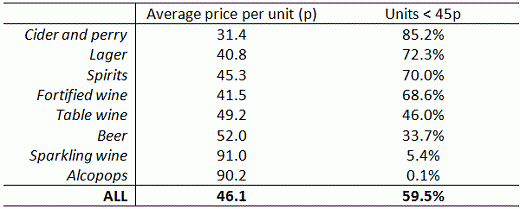Today the Home Office has published its consultation on policies to reduce the social costs associated with alcohol consumption. The most high-profile measure is a planned minimum unit price (MUP) for alcohol for England and Wales aimed at ensuring that “alcohol can only be sold at a sensible and responsible price”. The Government proposes that the minimum price should be 45p per unit (a unit is 10ml of pure alcohol); the Scottish government is already planning to introduce a MUP of 50p from next April.
As we have argued before, a preferable way of establishing a price floor for alcohol would be to reform the existing alcohol tax system in two ways. First, move towards a more equal tax treatment of different types and strengths of alcohol in which the tax is based on alcohol content. Second, restrict alcohol from being sold for less than the total tax due on each product to prevent tax increases from being absorbed by retailers. Whilst this reform would affect all alcohol, not just cheaper products, it would at least ensure any additional revenues flow to the Exchequer. By contrast, a minimum price would act as a transfer to the alcohol industry. The size of any windfall from minimum pricing and precisely who benefits is unclear: it would depend on the supply- and demand-side responses to the policy and the contractual arrangements between producers and manufacturers. Nevertheless the sums involved could be large: if there were no behavioural response at all, we estimate that a 45p MUP could transfer almost £1.4 billion per year from alcohol consumers to the off-licence alcohol industry.
To look at the effect of a 45p MUP we use detailed data recording the off-licence alcohol purchased by more than 21,000 households in 2010. The data do not include alcohol bought in pubs and restaurants. However, it is unlikely that a minimum price would have much direct effect for on-trade prices.
The consultation claims that minimum pricing is intended to “reduce the availability of alcohol sold at very low or heavily discounted prices”. However, we find that very nearly 60% of off-licence units cost less than 45p (Table 1), suggesting that the impact of minimum pricing is not just on the very cheapest alcohol. There are big differences across alcohol types: 85% of cider units would be directly affected by a 45p MUP, whilst alcopops and sparkling wines are relatively unaffected.
Table 1: Average off-licence retail price per unit and proportion of units under 45p, by alcohol type

Source: calculated using data from Kantar Worldpanel, 2010. Note: prices uprated to October 2012 values using the all-items RPI.
The effects also vary across different types of household. Low income households would see the largest increase in prices. Households with incomes below £10,000 per year pay on average 43p per unit, and 69% of their units cost less than 45p. This compares to an average cost of 53p per unit for those with incomes above £60,000, for whom 44% of units cost less than 45p.
Heavy drinkers would also be more directly affected. Households consuming fewer than 7 units of off-licence alcohol per adult per week pay just over 50p per unit on average, compared to almost 42p for those consuming more than 35 units per adult per week. Despite this, the impact of minimum pricing would certainly be felt by moderate drinkers as well. More than 48% of units purchased by those drinking less than 7 units per adult per week cost less than 45p, compared to 73% of units for the heavy drinkers.
Table 2 estimates the increase in total food and drink spending that would result from a 45p MUP, assuming no changes in consumer or retailer behaviour except that alcohol sold below the minimum price rises to 45p per unit. The average effect is about 0.9% of grocery budgets, or £32 per year in cash terms. The impact is quite similar for different income groups on average. The largest effect, 8.3% of grocery budgets on average, is felt by heavy drinkers with household incomes below £10,000 per year. However, only 3% of households in this income group fall into this consumption range (a similar share to other income groups). By contrast, almost a quarter of households in this income group do not consume off-licence alcohol at all, and so would not be directly affected by minimum pricing.
Table 2: Proportional increase in food and drink spending following 45p minimum price, by income group and alcohol consumption level (units per adult per week)

Source: calculated using data from Kantar Worldpanel, 2010. Note:
The most important issue in determining the impact of minimum pricing will be whether those who generate the greatest social harms from their consumption drink less as a result of the policy. That will depend on how well targeted on those drinkers a minimum price is and how their consumption responds to price rises – something we know relatively little about. Even less is known about how producers and manufacturers might respond and what this will mean. For example, the Office of Fair Trading recently noted that a MUP could give retailers an incentive to market low-cost alcohol more aggressively as it will raise the profit margin on each unit sold. Other important questions are what happens to the price of alcohol which is already selling above the minimum price? What happens to the range of alcohol offered for sale? What happens to the prices of other products besides alcohol? All of these issues will be crucial in judging the efficacy of the policy and should form part of any robust evaluation of its impact. It would be preferable, though, to pursue reforms which would allow something close to a minimum price to be implemented through the alcohol tax system.









